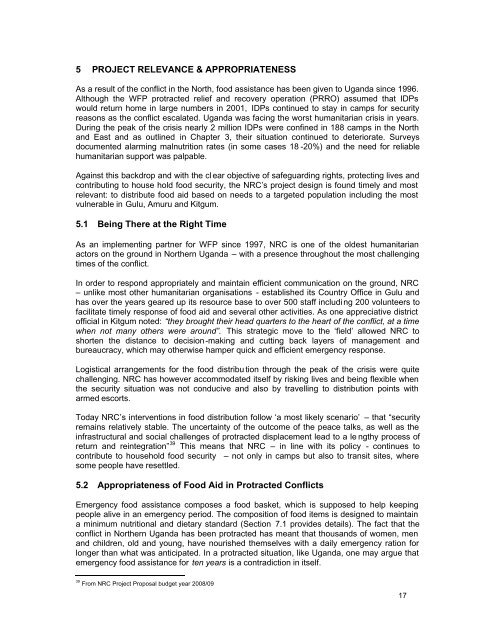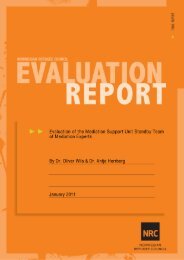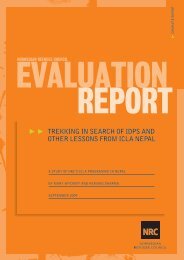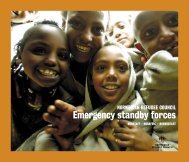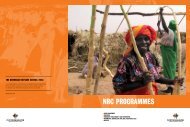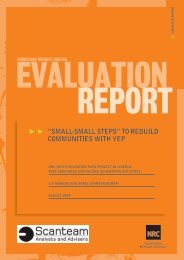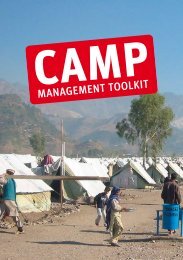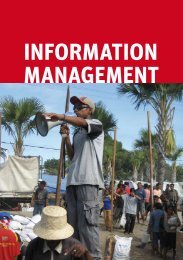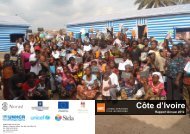evaluation of general food distribution in northern uganda: gulu ...
evaluation of general food distribution in northern uganda: gulu ...
evaluation of general food distribution in northern uganda: gulu ...
Create successful ePaper yourself
Turn your PDF publications into a flip-book with our unique Google optimized e-Paper software.
5 PROJECT RELEVANCE & APPROPRIATENESSAs a result <strong>of</strong> the conflict <strong>in</strong> the North, <strong>food</strong> assistance has been given to Uganda s<strong>in</strong>ce 1996.Although the WFP protracted relief and recovery operation (PRRO) assumed that IDPswould return home <strong>in</strong> large numbers <strong>in</strong> 2001, IDPs cont<strong>in</strong>ued to stay <strong>in</strong> camps for securityreasons as the conflict escalated. Uganda was fac<strong>in</strong>g the worst humanitarian crisis <strong>in</strong> years.Dur<strong>in</strong>g the peak <strong>of</strong> the crisis nearly 2 million IDPs were conf<strong>in</strong>ed <strong>in</strong> 188 camps <strong>in</strong> the Northand East and as outl<strong>in</strong>ed <strong>in</strong> Chapter 3, their situation cont<strong>in</strong>ued to deteriorate. Surveysdocumented alarm<strong>in</strong>g malnutrition rates (<strong>in</strong> some cases 18 -20%) and the need for reliablehumanitarian support was palpable.Aga<strong>in</strong>st this backdrop and with the cl ear objective <strong>of</strong> safeguard<strong>in</strong>g rights, protect<strong>in</strong>g lives andcontribut<strong>in</strong>g to house hold <strong>food</strong> security, the NRC’s project design is found timely and mostrelevant: to distribute <strong>food</strong> aid based on needs to a targeted population <strong>in</strong>clud<strong>in</strong>g the mostvulnerable <strong>in</strong> Gulu, Amuru and Kitgum.5.1 Be<strong>in</strong>g There at the Right TimeAs an implement<strong>in</strong>g partner for WFP s<strong>in</strong>ce 1997, NRC is one <strong>of</strong> the oldest humanitarianactors on the ground <strong>in</strong> Northern Uganda – with a presence throughout the most challeng<strong>in</strong>gtimes <strong>of</strong> the conflict.In order to respond appropriately and ma<strong>in</strong>ta<strong>in</strong> efficient communication on the ground, NRC– unlike most other humanitarian organisations - established its Country Office <strong>in</strong> Gulu andhas over the years geared up its resource base to over 500 staff <strong>in</strong>clud<strong>in</strong>g 200 volunteers t<strong>of</strong>acilitate timely response <strong>of</strong> <strong>food</strong> aid and several other activities. As one appreciative district<strong>of</strong>ficial <strong>in</strong> Kitgum noted: “they brought their head quarters to the heart <strong>of</strong> the conflict, at a timewhen not many others were around”. This strategic move to the ‘field’ allowed NRC toshorten the distance to decision-mak<strong>in</strong>g and cutt<strong>in</strong>g back layers <strong>of</strong> management andbureaucracy, which may otherwise hamper quick and efficient emergency response.Logistical arrangements for the <strong>food</strong> distribu tion through the peak <strong>of</strong> the crisis were quitechalleng<strong>in</strong>g. NRC has however accommodated itself by risk<strong>in</strong>g lives and be<strong>in</strong>g flexible whenthe security situation was not conducive and also by travell<strong>in</strong>g to <strong>distribution</strong> po<strong>in</strong>ts witharmed escorts.Today NRC’s <strong>in</strong>terventions <strong>in</strong> <strong>food</strong> <strong>distribution</strong> follow ‘a most likely scenario’ – that “securityrema<strong>in</strong>s relatively stable. The uncerta<strong>in</strong>ty <strong>of</strong> the outcome <strong>of</strong> the peace talks, as well as the<strong>in</strong>frastructural and social challenges <strong>of</strong> protracted displacement lead to a le ngthy process <strong>of</strong>return and re<strong>in</strong>tegration” 39 This means that NRC – <strong>in</strong> l<strong>in</strong>e with its policy - cont<strong>in</strong>ues tocontribute to household <strong>food</strong> security – not only <strong>in</strong> camps but also to transit sites, wheresome people have resettled.5.2 Appropriateness <strong>of</strong> Food Aid <strong>in</strong> Protracted ConflictsEmergency <strong>food</strong> assistance composes a <strong>food</strong> basket, which is supposed to help keep<strong>in</strong>gpeople alive <strong>in</strong> an emergency period. The composition <strong>of</strong> <strong>food</strong> items is designed to ma<strong>in</strong>ta<strong>in</strong>a m<strong>in</strong>imum nutritional and dietary standard (Section 7.1 provides details). The fact that theconflict <strong>in</strong> Northern Uganda has been protracted has meant that thousands <strong>of</strong> women, menand children, old and young, have nourished themselves with a daily emergency ration forlonger than what was anticipated. In a protracted situation, like Uganda, one may argue thatemergency <strong>food</strong> assistance for ten years is a contradiction <strong>in</strong> itself.39From NRC Project Proposal budget year 2008/0917


